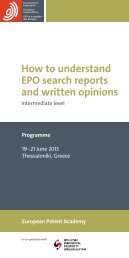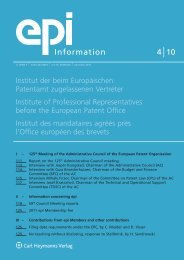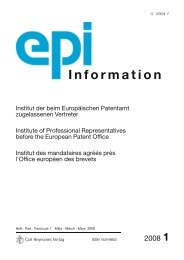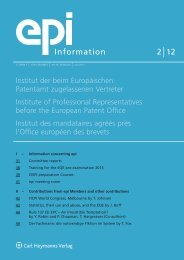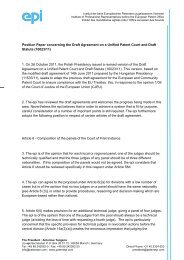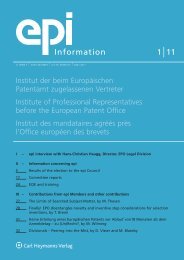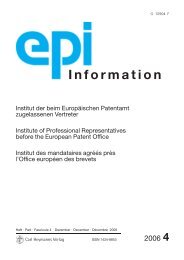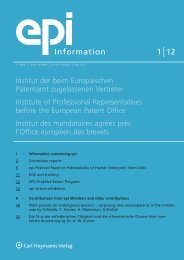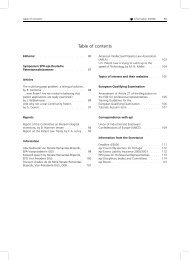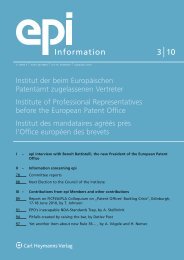epi Information 2/2009
epi Information 2/2009
epi Information 2/2009
You also want an ePaper? Increase the reach of your titles
YUMPU automatically turns print PDFs into web optimized ePapers that Google loves.
58 Articles <strong>Information</strong> 2/<strong>2009</strong><br />
It becomes undisputable that in T1143/05 the invention<br />
disclosed in EP2 is the same as in EP1: biocide<br />
compositions showing a synergistic effect between<br />
MIT and BIT.<br />
7 – The legal problem raised by this decision is also: is a<br />
disclaimer acceptable when it is introduced in a subsequent<br />
patent application but absent from the priority<br />
document? This question has not been debated by the<br />
Board of Appeal in the present case.<br />
The decision T1443/05 shows the EPO’s will to accept<br />
to grant a disclaimer only in a very restrictive number of<br />
cases. It is interesting to note that the Board did not refer<br />
to the Enlarged Board of Appeal decision G1/03 on<br />
Disclaimers. This absence of any reference to G1/03<br />
may be explained by the non application of this decision<br />
to the present case since the decision G1/03 deals with a<br />
disclaimer not present in the application as filed but<br />
introduced during the prosecution.<br />
In T1443/05, the „disclaimer“, or in fact the exclusion,<br />
was present in the original text of EP2 at the time of filing.<br />
Thus, this is not a „disclaimer“ in the sense of G1/03.<br />
8 – We believe that G1/03 cannot apply to discuss the<br />
priority right when a disclaimer was introduced in a<br />
subsequent EP2.<br />
Indeed, the ruling for allowing a disclaimer as set forth<br />
in G1/03 should not apply between the priority EP1 and<br />
the subsequent EP2 because there is no ground in the<br />
EPC not to accept a disclaimer INITIALLY present in an<br />
application.<br />
But following T1443/05, if this disclaimer is absent<br />
from the priority EP1, the priority might be invalid for<br />
studying validity of EP2.<br />
Again, this consideration appears to be right if the<br />
invention of the subsequent EP2 is not the same.<br />
We believe that in T1443/05, the question whether<br />
the invention is the same has not been correctly debated<br />
and our conclusion is that the invention of EP2 is the<br />
same as the invention of EP1. This is all the more justified<br />
because the 10 working examples from the priority EP1<br />
are included in the subsequent EP2 and that the patentability<br />
was resulting from the synergy of the combination<br />
of MIT with BIT already disclosed in EP1.<br />
9 – Another approach to this legal situation is to<br />
consider that all common parts between the priority<br />
EP1 and the subsequent EP2, CAN NOT destroy the<br />
novelty of EP2’s claims where the EP2’s claims<br />
encompass the subject-matter of EP1.<br />
One may see in EP2’s claim 1 an infinity of embodiments<br />
covering compositions comprising MIT+BIT but<br />
not those comprising CMIT. According to this reasoning,<br />
the priority may be valid since EP1 covers an infinity of<br />
compositions comprising MIT+BIT excluding CMIT and<br />
compositions comprising MIT+BIT+CMIT.<br />
Such an approach has been taken in T665/00 (L’Oréal<br />
vs. Parfums Christian Dior), but this decision has not<br />
been followed since considered erroneous including by<br />
the Doctrine (Notably P. Vigand) and appears to be yet<br />
overruled by T1443/05.<br />
We do believe that the priority document is not any<br />
document from the prior art but a specific one from the<br />
same Applicant/inventor(s) which serves to establish the<br />
priority and the benefit from an earlier filing date, under<br />
Paris Convention.<br />
10 – In the decision, the board identified a new<br />
technical problem solved by the invention as claimed<br />
in EP2. We believe that studying the technical problem<br />
when assessing the validity of a priority is not appropriate<br />
because the technical problem may change depending<br />
on the prior art, and especially of the closest prior art as<br />
identified in the problem-solution approach.<br />
The invention is relating to the technical features not<br />
to the technical problem. The technical problem is only<br />
of interest to appreciate the patentability of the technical<br />
feature(s). Accordingly, what is only to be taken into<br />
account is the disclosure of the technical feature(s) in the<br />
priority document. Accordingly, The Board was mistaken<br />
in decision T1443/05.<br />
V – Conclusions<br />
1. As a first conclusion, care should be taken not to<br />
apply this decision T1443/05 to the case where the<br />
technical features are the same in the priority document<br />
and in the subsequent Patent, even if a disclaimer<br />
is present in the subsequent Patent.<br />
2. We believe that the EPO’s decision T1443/05 may<br />
apply only when the technical features of the subsequent<br />
application or patent are different from the<br />
priority document. In T1443/05 the Board considered<br />
that the technical problem has been<br />
changed during the priority year and that the invention<br />
was not the same. This explains why the priority<br />
was held invalid.<br />
3. However we believe that this EPO decision should<br />
not be legally acceptable because the facts appear to<br />
show that the „invention“ in the priority document<br />
and the subsequent application were the same, even<br />
if a disclaimer was introduced.<br />
4. To invalidate a priority claim because the technical<br />
problem is not the same as the priority document is<br />
not appropriate. The invention is relating to the<br />
technical features not to the technical problem.<br />
The technical problem is only of interest to appreciate<br />
the patentability of the technical feature(s).<br />
Accordingly, what is only to be taken into account<br />
is the disclosure of the technical feature(s) in the<br />
priority document. Accordingly, The Board was mistaken<br />
in decision T1443/05.<br />
5. Besides, this decision may apply to a very wide<br />
number of cases but should not be followed.<br />
Care should be taken not to be entrapped in a<br />
legal situation where the patent system is far away<br />
from the problems of industry. This may be the case<br />
here where an invention is unpatentable because of<br />
the existence of a prior art not known at the priority<br />
date and discovered by the Search Report before the<br />
PCT or European Patent application filing. Since<br />
under T1443/05, the priority claimed in EP2 may<br />
be held invalid and the priority EP1 is becoming prior<br />
art under art 54(3), it follows that EP1 would destroy



